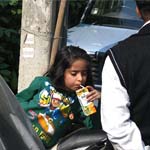Peer Pressure in Children

Peer Pressure in Children
Children today are under constant social pressure every time they are around people. Children and teenagers feel this pressure in order to conform to their peer groups, whether it is their friends’ circle or their siblings and cousins.
Peer pressure influences and acts as a defining factor in the personality and behavior traits, of children. The Pressure can influence the way they dress, their preference in music, food, TV shows, favorite actors and movies. Peer pressure is also a decisive factor in the social activities they engage in. The intensity of it differs from person to person and in different situations.

Peer presuure often makes kids irritable and vulnerable.
Peer pressure might be between two people of the same age-group or at the same work environment. It can start at an early age, depending on the choice of games they play. It increases as time passes, and they grow older. It becomes more intense during the teenage years and it may also continue in their adulthood.
Children today have started using technology, which is gradually increasing the peer pressure amongst kids. Any new phone or gadget that comes to the market can act as a weapon, to force kids into being subjected to peer pressure. A decade ago, same things used to happen, but instead of technology and gadgets, there were collectible items like Tazos, stickers, tops, temporary tattoos, card games etc. Back then, Media in the form of Television shows used to push their commercial objectives, to the kids, who used to compete to buy them. The kid with the least collectibles was looked down upon and made fun of.
When kids reach the adolescence years, they start spending more time with friends than with family, and their friends’ approval becomes crucial, in order to be in the group and/or the game. It has also been observed that peer pressure mostly affects kids who have friends of the same sex. They will spend most of their time socializing virtually, over social networking sites and messaging services, to show that they are “cool”. Most of the kids give in to this peer pressure either because they get bullied or ridiculed, if they were not at par, or ahead of their friends or if they want to fit in or be admired by their friends. The idea behind following a trend that everyone is following is to make sure that they aren’t left behind.

Kids start copying, and demanding things in trend.
Sometimes, the peer pressure leads to bad habits, like underage drinking, smoking, drugs, vandalizing, theft, bullying and sexual activities.
These things not only affect a child’s social and emotional behavior and growth, eating habits, sleeping, eating and dressing patterns, but also their physical and mental health and their growth.
Hence it is very important to talk to the kids and try to understand the current trend, and their insecurities. They need to understand that following some trends doesn’t make them “cool” but doing what’s right does. They should also be made to understand that their behavior, habits, dedication and performance is what matters, in the longer run, and not something as trivial as a phone, or some collecting cards.







